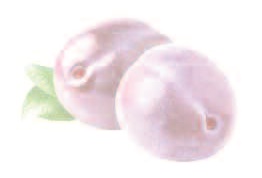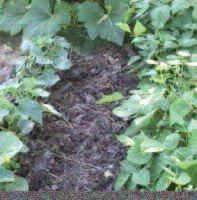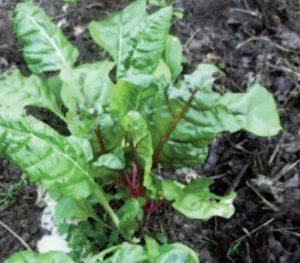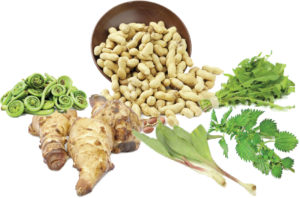 GARDEN WORKS
GARDEN WORKS
by Emily Cates
Part 1 of 2
For as long as there have been people who gardened in a climate such as ours here in Maine, the frost-free season has been eagerly anticipated. Much joy and excitement prevails when the ground is ready to plant heat-loving garden plants. Usually the date for all this falls upon or around Memorial Day. With that a few days behind us, let’s look at some warm-weather plants that would be happy to be planted anytime now. In this article we’ll include corn, beans, tomatoes, peppers, and eggplant. Next time we’ll discuss okra, artichokes, celery, melons and squash. In each article, we’ll also examine a few tips on growing them and making the most of our efforts.
Corn, a traditional provision of the Americas from ancient times, finds its way to our table in many forms, such as popcorn, cornmeal, sweet corn, baby corn, grits, hominy, and ornamental “Indian” corn. A large percentage of corn grown worldwide is actually cultivated as animal feed. The rest of the crop comes in an infinite variety of color patterns and flavors.
Most of us are acquainted with yellow or cream colored corn, but it is exciting to harvest brightly-colored ears of multicolored corn varieties. My favorite ornamental strain is ‘Earth Tones’ dent, and if you get a chance to see it, you might concur. Popcorn, which is a variety of corn that pops when dried and cooked due to the shape of the kernels, is delicious when homegrown. Look for a popcorn with the name of ‘Pennsylvania Dutch Butter Flavored’, which is so yummy when popped up on its own without adding anything else for flavor. The variety ‘Dakota Black’ is pretty good too, and ‘Calico’ is an ornamental popcorn.
If you’re looking to grow corn for cornmeal, try ‘Painted Mountain’, ‘Abenaki Calais Flint,’ or ‘Hopi Blue’. Grow ‘Japanese Hulless’ for baby corn when immature and popcorn when mature. Interested in a sweet corn that has that old-fashioned flavor without being too sweet? Try ‘Golden Bantam.’ ‘Country Gentleman’ is a good old-timey corn that is unique as it has no rows and the kernels are arranged in a zigzag, shoe peg pattern. Corn is a heavy feeder that likes full sun, and pollinates best when planted in row blocks rather than a single row. It cross-pollinates with other varieties- even from miles away- and the resulting ears will show the results of this; so keep in mind if planting near other corns pollinating at the same time.
Beans are a versatile addition to a garden. Being a legume, they fix nitrogen for the soil, as well as providing a green vegetable, shell beans, and dry beans for soups and such. Like corn, they come in a dazzling array of colors and forms. Green beans need not be green at all! ‘Dragon’s Tongue’ has cream-colored pods with purple stripes. ‘Royal Burgundy’ has striking purple pods, as does ‘Velour,’ which is a haricots vert type. ‘Red Noodle Yard Long’s impressive thin burgundy pods grow over 15 inches long and the rambling vines require something to climb on. Actually, varieties of beans called ‘”pole beans” are thought to be better tasting than bush beans. Grow them on poles, “tipis,” or a trellis of some sort. Recommended are ‘Northeaster’, ‘True Red Cranberry pole’, ‘Golden Gate,’ ‘Kentucky Wonder,’ ‘Christmas Lima,’ and ‘Purple Podded.’ ‘Scarlet ‘Runner’ is a type of vining ornamental bean with pretty red flowers and big, beautiful black and pink bean seeds that look almost spray-painted. Dry beans of every shape, size, and colors imaginable are also available. Look for ‘Tiger Eye,’ ‘Appaloosa,’ ‘Jacob’s Cattle,’ ‘Drabo,’ ‘Ireland Creek Annie,’ and ‘Calypso.’ Beans have moderate nutrient needs, and excessively rich soil will produce excessive vegetation. Stay out of the bean patch when it’s wet, as they can be susceptible to diseases. Plant with summer savory to improve bean growth.
Tomatoes are perhaps one of the most beloved garden vegetables. Once thought to be poisonous, they delight many gardeners today with a rainbow assortment and exquisite flavors. Really, I could devote a whole article on tomatoes, but I will restrain myself from doing so this time! I shamelessly grew and tried literally hundreds of different named varieties to find the best ones, and I’ll share with you some of my favorites: ‘Lillian’s Yellow Heirloom,’ ‘Cosmonaut Volkov'(red slicer), ‘Aunt Ruby’s German Green,’ ‘Amish Paste,’ ‘Yellow Pear,’ ‘Pink Brandywine,’ ‘Sungold,” Black Cherry,’ ‘Heart of Compassion,’ ‘Federle'(paste), ‘Opalka'(paste) ‘Cherokee Purple,’ and ‘Green Zebra.’ There are too many to list all of the ones I like, and some years the winners are losers and vice versa depending on weather and other conditions. But the above mentioned varieties have been consistently victorious. Since they are long-season plants, start seeds indoors in February – April, or plant seedlings from a friend, farm stand, garden store, etc. Every gardener seems to have some secret for growing the best tomatoes, and I admire the lore and legends I hear. I have found over the years that in my garden, tomatoes prefer to grow on a trellis and they like compost tea, seaweed/fish fertilizer, clean wood ashes, and mulch. Give them plenty of nutrients, but not too much. Good companions could include aromatic herbs such as basil, chives, thyme, and cilantro.
Peppers are likewise delightful in their diversity, ranging to sweet and mild, to blistering hot and spicy. Like tomatoes, the colors can be astonishingly beautiful and varied. Peppers can be big and blocky, long and skinny, round, tall, squat, lobed, or even mushroom-shaped. Look for ‘King of the North'(sweet, bell), ‘Chocolate'(sweet), ‘Round of Hungary'(sweet), ‘Beaver Dam'(mildly hot with seeds and ribs, sweet without), ‘Boldog Hungarian Spice'(paprika), ‘Czech Black'(hot), ‘Matchbox'(hot), ‘Purple Cayenne'(hot) ‘Hinkelhatz'(hot), ‘NuMex'(ornamental, hot), and ‘Mushroom'(hot!). Start indoors March – April, or plant seedlings from where you got your tomatoes. They can be a challenge to grow in some years, and like to be pampered with windbreaks and anything that shelters them from extremes of heat or cold or moisture levels. I find the most success when I plant peppers into black plastic IRT mulch. Pick the first fruits of the year as they mature, since the more you pick, the more will grow. Tomatoes, okra, basil, and onions are some of the plants said to be good companions to peppers.
Eggplants, too, are varied, and a perfect choice for a gardener looking for a challenge. I’ve found they appreciate similar conditions as peppers, with a good amount of compost (not too much) and black plastic IRT mulch. Start indoors or use seedlings. Look for the most possibly dependable varieties ‘Rosita’, ‘Applegreen’, ‘Pingtung Long’, ‘Diamond’, and ‘Rosa Bianca’.
Whatever varieties you prefer (there are infinite varieties to choose from!), you can find seeds from FEDCO, Johnny’s, Pinetree, Sandhill Preservation Center, and Baker Creek Heirloom Seeds. See you next time for the rest of this article. In the meantime, happy planting!
Read Part 2 here!
 GARDEN WORKS
GARDEN WORKS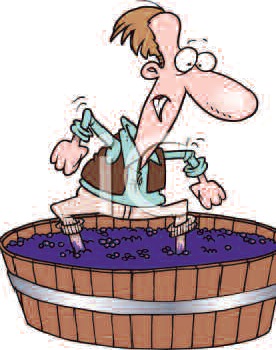 Making grape juice is refreshingly simple and an exciting departure from the occasional drudgery that can accompany preserving jar after jar of produce in the autumn-time kitchen. From there, the juice can be enjoyed right away, left a couple days to develop effervescence, or aged further into wine or vinegar. (I’ll leave it to you to determine how you wish to proceed.) For now, though, let’s look at the joyous occasion of extracting the juice the way it has been done for ages. From the vine to the press, we’ll see how to handle grapes in a way that will produce some of the yummiest juice in all the land.
Making grape juice is refreshingly simple and an exciting departure from the occasional drudgery that can accompany preserving jar after jar of produce in the autumn-time kitchen. From there, the juice can be enjoyed right away, left a couple days to develop effervescence, or aged further into wine or vinegar. (I’ll leave it to you to determine how you wish to proceed.) For now, though, let’s look at the joyous occasion of extracting the juice the way it has been done for ages. From the vine to the press, we’ll see how to handle grapes in a way that will produce some of the yummiest juice in all the land.

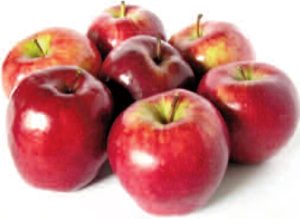 There’s no fancy recipe or anything. Simply use apples that are good enough on their own. I forgo adding sugar or spices, as I’m interested in the unique flavors of the fruits — especially if these flavors are particularly suit-able for sauce. (The sauce can always be doctored up later if need be.)
There’s no fancy recipe or anything. Simply use apples that are good enough on their own. I forgo adding sugar or spices, as I’m interested in the unique flavors of the fruits — especially if these flavors are particularly suit-able for sauce. (The sauce can always be doctored up later if need be.)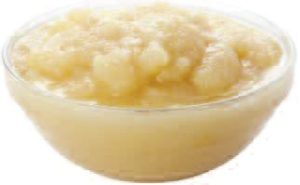 Drops are fine for sauce as long as they are washed well and used up quickly – preferably the day they are gathered. Some trees have the habit of dropping apples as they ripen, others drop because they are bad. I won’t pass up a good apple because of a bruise or wormhole, but I’ll make sure to inspect carefully and trim out any bad spots, staying clear of apple mold.
Drops are fine for sauce as long as they are washed well and used up quickly – preferably the day they are gathered. Some trees have the habit of dropping apples as they ripen, others drop because they are bad. I won’t pass up a good apple because of a bruise or wormhole, but I’ll make sure to inspect carefully and trim out any bad spots, staying clear of apple mold.